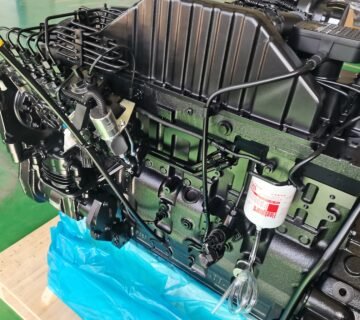The Future of Cummins Engines in a Zero-Emissions World
As global industries accelerate toward carbon neutrality, Cummins Inc. is redefining its legacy as a diesel engine titan by spearheading innovations that bridge traditional power with a zero-emissions future. Through its Destination Zero strategy, Cummins is investing in hydrogen combustion, battery electric systems, renewable fuels, and multi-fuel platforms to deliver sustainable power solutions without compromising performance. This article explores how Cummins engines are evolving to lead the clean energy transition while maintaining their reputation for reliability and versatility.

- Hydrogen Combustion: Powering Heavy-Duty Applications
Cummins is pioneering hydrogen internal combustion engines (H2-ICE) as a viable pathway to zero-emissions for industries reliant on high-torque, durable power. The Cummins X15H, a 15-liter hydrogen engine, exemplifies this shift. Designed to operate on green hydrogen, the X15H produces near-zero CO₂ emissions while delivering 500+ horsepower and torque comparable to diesel—ideal for long-haul trucking, mining, and marine applications.
Key advantages include:
– Fuel Flexibility: Compatible with both gaseous and liquid hydrogen.
– Existing Infrastructure: Utilizes modified diesel engine architecture, easing adoption for fleets.
– Carbon Capture Readiness: Partnerships with startups like EnerVenue aim to integrate hydrogen production and storage solutions.
By 2027, Cummins plans to deploy H2-ICE engines in pilot programs with Walmart and J.B. Hunt, targeting a 90% reduction in lifecycle emissions versus diesel.
- Battery Electric Solutions: Electrifying Urban Mobility
For urban and medium-duty applications, Cummins’ battery electric powertrains are gaining traction. The PowerDrive 8000 system, used in electric buses and delivery trucks, offers up to 350 kWh capacity and a 250-mile range. Unlike gasoline hybrids, Cummins’ designs prioritize modularity, allowing seamless integration with existing chassis and rapid charging via 1,500V DC fast-charging networks.
Case in point: The New Flyer Xcelsior CHARGE NG™ bus, powered by Cummins, reduces urban NOx and PM emissions to zero while cutting energy costs by 40% over diesel counterparts.
- Renewable and Alternative Fuels: Bridging the Transition
Cummins engines are increasingly compatible with low-carbon fuels to support gradual decarbonization:
– Renewable Diesel (HVO): A drop-in replacement for diesel, offering up to 90% fewer lifecycle emissions.
– B20 Biodiesel: Supported by post-2007 engines, reducing CO₂ by 15%.
– Renewable Natural Gas (RNG): Paired with Cummins’ 6.7L natural gas engine, it achieves carbon-negative footprints when sourced from landfills.
The X12N natural gas engine, for instance, powers UPS delivery fleets with 30% lower fuel costs and compliance with California’s Advanced Clean Truck Regulation.
- Multi-Fuel Platforms: Flexibility as a Strategy
Cummins’ HELM™ (Hybrid Electric Modular Platform) epitomizes adaptability. This architecture supports diesel, hydrogen, natural gas, and hybrid configurations on a single engine block, enabling fleets to transition fuels without overhauling infrastructure. For example, a HELM™-equipped generator can switch between hydrogen and biodiesel based on availability, ensuring uptime in regions with underdeveloped green energy grids.
- Advanced Aftertreatment: Maximizing Legacy Engines
Even as Cummins innovates, it optimizes existing diesel engines for minimal emissions. The latest X15 Efficiency Series integrates:
– Dual-Stage Turbocharging: Enhances combustion efficiency, cutting NOx by 20%.
– Next-Gen SCR Systems: Use AI-driven dosing to reduce DEF consumption by 15%.
– Predictive Maintenance: IoT sensors alert operators to filter replacements, preventing downtime.
These upgrades ensure compliance with Euro VII and EPA 2027 standards, extending diesel’s viability in a transitioning market.
- Collaborations and Infrastructure Development
Cummins recognizes that technology alone cannot achieve zero-emissions—infrastructure is critical. Strategic partnerships include:
– Green Hydrogen Hubs: Collaborating with Air Products to build 50+ hydrogen refueling stations across Europe by 2025.
– Charging Networks: Working with ChargePoint to deploy high-power chargers along U.S. freight corridors.
– Carbon Capture: Joint ventures with Svante to develop onboard CO₂ capture systems for maritime engines.
- Challenges and Cutting-Edge Innovations

Transitioning to zero-emissions presents hurdles:
– Energy Density: Hydrogen and batteries lag diesel in energy storage. Cummins’ answer? Solid-state battery research aiming to double EV range by 2030.
– Cost Parity: Renewable fuels remain pricier. Cummins’ TriGen systems offset this by producing hydrogen, electricity, and heat from biogas.
– Cold-Weather Performance: Hydrogen engines face cold-start issues. Cummins’ H2-ICE Arctic Package uses waste heat recovery to ensure operation at -40°F.
Conclusion: Leading the Charge Without Leaving Industries Behind
Cummins’ roadmap to a zero-emissions world is neither a pivot nor a compromise—it’s an expansion of capability. By advancing hydrogen combustion, electric powertrains, and multi-fuel platforms, Cummins ensures that industries from agriculture to aerospace can decarbonize at their own pace without sacrificing power.
The Destination Zero strategy isn’t just about eliminating emissions; it’s about reimagining Cummins engines as the backbone of a sustainable global economy. With relentless R&D, strategic partnerships, and a commitment to accessibility, Cummins is proving that the future of power is both green and unstoppable.





No comment